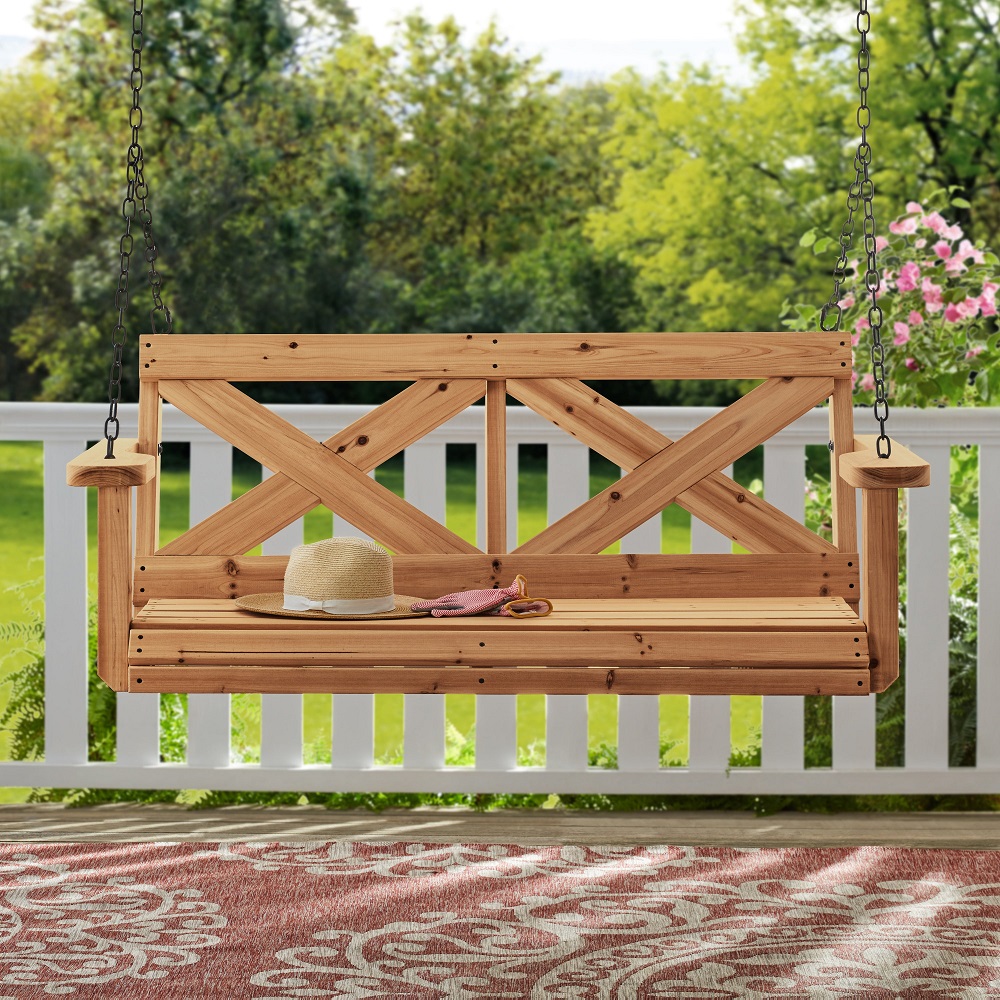Building a porch swing is a fantastic way to add charm and relaxation to your outdoor space. Whether you’re a seasoned DIYer or a beginner, constructing your own porch swing can be a rewarding project. With the right materials, tools, and instructions, you can create a beautiful and functional swing that will provide years of enjoyment. This step-by-step DIY guide will walk you through everything you need to know to build your very own porch swing.
Materials and Tools Required for Building a Porch Swing
Before you start building your porch swing, it’s essential to gather all the necessary materials and tools. Having everything on hand will make the process smoother and more efficient.
Materials
The primary materials you’ll need for your porch swing include:
- Wood: Choose a durable hardwood such as cedar, redwood, or oak for the frame and seat slats. These woods are weather-resistant and ideal for outdoor use.
- Swing Hardware: This includes heavy-duty eye bolts, washers, and carabiners to secure the swing to the support beams.
- Rope or Chain: You’ll need either sturdy rope or chain to suspend the swing. Make sure it’s strong enough to handle the weight of the swing and its users.
- Screws and Nails: Galvanized screws and nails are best for outdoor furniture as they resist rust and corrosion.
Tools
The tools required for building the porch swing include:
- Saw: A circular saw or miter saw to cut the wood to the required dimensions.
- Drill: For drilling holes for the bolts and screws.
- Screwdriver: A power or manual screwdriver for securing screws.
- Measuring Tape: To ensure accurate measurements when cutting the wood.
- Sandpaper: To smooth rough edges of the wood after cutting.
- Level: To make sure your swing is level when hanging.
Having the right materials and tools will help ensure that your project goes smoothly and the finished porch swing is both sturdy and beautiful.

Step 1: Plan and Design Your Porch Swing
The first step in building your porch swing is to plan and design it. This will include deciding on the size, style, and materials of your swing.
Dimensions of the Porch Swing
When planning the dimensions of your porch swing, consider the number of people you want it to accommodate. A typical porch swing seat is about 48 inches long, which comfortably fits two adults. However, you can adjust the size based on your preference. The height of the swing can vary, but a standard height is about 18 inches from the seat to the ground.
Additionally, you’ll need to design the backrest and armrests. A simple slatted backrest works well for most porch swings, but you can get creative with different styles, like curved backs or intricate patterns. Similarly, armrests can be designed as basic slats or more decorative pieces with curves or angles.
Sketching the Design
It’s helpful to sketch out your porch swing design before you begin construction. Drawing the swing from multiple angles (side view, front view) will give you a clear understanding of how all the pieces fit together. Make sure to note all the measurements for each piece of wood.
Once you have a solid design, review your materials list and check that you have everything you need. If you’re not sure about your design, plenty of online plans and templates are available to help guide you.
Step 2: Cutting the Wood
Now that you have your design and materials ready, it’s time to cut the wood. Cutting the wood accurately is essential for ensuring that your swing frame and seat fit together properly.
Cutting the Seat Slats
Start by cutting the slats for the seat of the swing. If you are using 1×4 lumber, you’ll need to cut these to the length of the swing. Most porch swing designs use around 6-8 slats for the seat, depending on how wide you want the swing. Make sure to space the slats evenly when assembling them later.
Cutting the Frame Components
Next, cut the pieces for the frame. This will include the side supports, front and back cross supports, and the top frame. Measure twice, and cut once to ensure that all the pieces are the correct size. If your design includes a backrest, cut those pieces as well. For extra stability, it’s a good idea to use wood glue in addition to screws when joining the frame pieces.
Sanding the Wood
After all the pieces are cut, use sandpaper to smooth the edges of the wood. Sanding is important not just for aesthetics, but for safety as well. Rough edges could splinter or cause discomfort when sitting on the swing. Sand the surface of each piece, especially the seat slats, to ensure there are no sharp edges.

Step 3: Assemble the Frame of the Porch Swing
Once all your pieces are cut and sanded, it’s time to start assembling the frame of the swing. This will be the backbone of your porch swing, and it needs to be sturdy enough to support the weight of the seat and anyone sitting on it.
Attaching the Side Supports
Start by attaching the side supports to the bottom cross supports. Use screws to secure them tightly, making sure the frame is square. If needed, use a level to ensure that the supports are even and that the sides are perpendicular to the base.
Securing the Top Frame
Once the bottom and side pieces are in place, attach the top frame. This part will be where the swing chains or ropes are secured. Be sure to double-check the level of the frame, as it needs to hang evenly for the swing to function properly. If the top frame is slanted, the swing will not sit correctly.
Adding the Backrest (Optional)
If you’ve decided to include a backrest in your design, now is the time to attach it. The backrest is typically attached to the top frame at an angle, which makes sitting on the swing more comfortable. Secure the backrest slats with screws, making sure they are evenly spaced and aligned properly with the frame.
Step 4: Attaching the Seat Slats
The seat slats are what make your swing both functional and comfortable. Attaching them requires precision to ensure a secure and even seating area.
Aligning the Seat Slats
Begin by laying the seat slats on the frame and spacing them evenly. Use a measuring tape to make sure the spacing between each slat is consistent. For added comfort, you may want to leave a small gap between each slat so water can drain through if the swing is exposed to rain.
Securing the Slats
Once you’ve positioned the slats, use screws to secure them to the frame. Make sure that the screws go into the frame at an angle to hold the slats tightly in place. It’s also a good idea to add wood glue to the slats before screwing them in to provide extra stability.
Reinforcing the Seat
For additional reinforcement, you can add cross supports underneath the seat slats. This will help distribute weight more evenly and make the swing more durable. Attach the cross supports with screws and make sure they are centered underneath the seat.

Step 5: Installing the Swing Chains or Ropes
The next step is to install the swing chains or ropes that will suspend your swing from the ceiling or support beam. This is a critical step in ensuring the swing is securely hung.
Attaching the Eye Bolts
Drill holes into the top frame of your swing and insert heavy-duty eye bolts. These bolts will serve as the anchors for the swing chains or ropes. Make sure to tighten the bolts securely so that they can support the weight of the swing.
Hanging the Swing
Next, measure and cut your chains or ropes to the appropriate length. You’ll want the swing to hang at a comfortable height, typically about 18 inches from the ground. Attach the chains or ropes to the eye bolts and secure them with carabiners or knots.
For added security, you may want to attach the other ends of the chains or ropes to a strong ceiling beam or support structure. Make sure the swing is level and stable before testing it out.
Step 6: Finishing Touches and Painting
Your porch swing is almost complete! The final step is to add finishing touches that will enhance its appearance and durability.
Sanding and Staining the Swing
Before painting or staining your swing, give it one last sanding to smooth out any rough areas. Then, apply a weather-resistant stain or paint to protect the wood from the elements. A good-quality outdoor wood finish will prevent the wood from rotting, cracking, or fading in the sun.
Adding Cushions and Pillows
To make your porch swing more comfortable, add cushions or pillows. You can purchase outdoor cushions designed for porch swings, or make your own with fabric that is durable and resistant to fading.
Conclusion
Building a porch swing can be a fun and rewarding DIY project that adds beauty and relaxation to your outdoor space. By following these steps and taking the time to choose the right materials, tools, and design, you can create a sturdy and stylish swing that will provide years of enjoyment for you and your family. Whether you enjoy reading a book, taking a nap, or simply enjoying the view, a custom-built porch swing is a perfect addition to any home.
